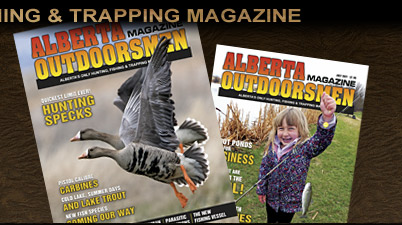The big buck stood just a mere 45-yards away. Frigid temperatures had turned the back of his neck into a mane of frozen ice. His face was much the same with what appeared to be little more than frozen slits for eyes. But he was aggressive, chasing a doe off the old logging road and into the willows behind my blind. This was the second of about nine visits the buck would make to my blind over the next four days that I was setup just off the old logging road. He was a good mature buck and a shooter in the eyes of many, probably pushing the 145 mark with a great set of jet-black brow tines. He just wasn’t very wide, maybe 15 inches. Everything grew straight up from a thick burr. His right side was palmated holding five points, the left just four. I’d had ample opportunity to observe the buck and knew exactly what he carried. Twice he had walked right up to me while my camera was pointed out a corner of the canvas window of my blind. I’m sure he knew I was inside, he just had to.
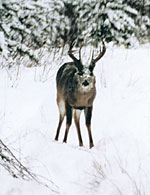 |
| The Dolt Buck. |
The buck became known as the “Dolt Buck” and the more I showed his photo and the small snippets of video I’d managed to the Alberta crew in the hotel the more I was encouraged to take him. I knew the buck would return to my blind though, so there was no hurry. He’d come all right, the oats and barley I’d laid out to both the right and left of my blind, 45 yards away, almost guaranteed it. We were in Saskatchewan and we were baiting deer.
Baiting has always been and always will be a contentious issue. For years the debate over whether baiting is ethical or not has plagued hunters. Some do, some don’t. Some jurisdictions allow baiting, others don’t. Some, like Alberta, make exceptions based on the animal being hunted. But baiting, for the most part, is accepted just about everywhere for one animal or another.
I hadn’t given much thought to baiting deer. I knew it was being done in several states and provinces, including Saskatchewan, but much like baiting bears it didn’t concern me.
Over the next two issues I’m going to take a look at baiting deer and what the positives and the negatives are, because there are both. I can only give you my personal experience, which is very limited, but I will also look at some of the facts as presented in numerous studies that have taken place over the years. It is not a simple issue, nor should it be. There are just far too many varying opinions, and significant scientific studies that say we shouldn’t be baiting deer or bears. But for now, I want to expound on the positives and in the next issue we’ll look at some of the negatives.
 |
| Claudio Ongaro preparing a bait site for white-tailed deer. |
I was hunting with Claudio Ongaro and Shawn Comisky in northwestern Saskatchewan. To my surprise the small town we stayed in and its hotel were full of hunters, mostly from Alberta with a handful from British Columbia. Our evenings were spent in the hotel bar where the day’s hunt was parlayed from hunter to hunter. Regularly a new deer would be brought in each night and the bar would empty as hunters would rush out to see the newest trophy. It was refreshing. Seldom are several hunters gathered in the same location while the hunt is on. And hunters are hunters; we all have something in common, making conversation and friendships plentiful.
Shawn had previously picked up our bait: seven 50-pound bags of various feeds—oats, an oats and barley mixture, another with molasses, cracked-corn and several pounds of salt and some sugar. To me it didn’t seem like much considering we had a week. But, surprisingly, deer don’t take too much of the high-protein feed. From conversation with other hunters I discovered that peas were a definite favourite and that the outfitters in the area like to use alfalpha bales, broken down into allowable sizes. By this I mean the amount of bait you can use is limited by regulation. In Saskatchewan, no more than ten gallons of bait can be used per baiting site at one time, or no more than two bales not exceeding 198 pounds. You also cannot store bait at or near your baiting site, it must be carried, or driven to your location. You must also post a sign at your baiting location that includes your name, address and phone number, although Saskatchewan’s hunting regulations are extremely vague and leave far too much open for interpretation in this regard. Other provinces that allow the baiting of deer, such as Ontario, will have different regulations.
When we arrived at our chosen location in Saskatchewan, our first order of business was to put out our bait. Finding well-used trails seemed to be a non-issue—there just seemed to be a tremendous amount of deer activity in the area. We wanted to put out three blinds and six bait piles. Two for each blind. And in less than a full afternoon we had three bait sites set within a couple miles of each other.
Setting out the bait was little more than pouring it out of the bags and onto the ground in long lines. If the bait is piled, deer might fight over it. A line of about eight feet long allows more than one deer at a time to feed, or so goes the theory. With our bait set out and our blinds placed, we headed to town to check into our rooms. Now it was just a matter of the deer finding our bait. It was Sunday; opening day for non-resident Canadians was the following morning.
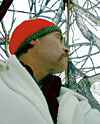 |
| Rob Miskosky inside his bait station blind. |
When I arrived the next morning to my bait site I was disappointed to find that my bait had yet to be found. Fresh snow the day before showed no signs of deer but I decided I would settle into my blind anyway. It was -30 Celsius and my blind had a propane heater, reason enough to stay put.
Within a couple of hours my first deer appeared. A young doe that stopped short on the trail she was following and moved to my bait. She stayed for little more than five minutes before moving on. Only one other deer showed up at my bait that day, a young 5X5 buck that was off to a good start in the antler department but not a shooter. I left at dark expecting that either Shawn or Claudio had connected as I’d heard a shot late that afternoon from their general direction.
Meeting at a chosen location my suspicions were confirmed. Claudio had killed a great buck after having numerous deer, including eight bucks, around him all day long. Shawn had also had an exciting day seeing twelve different bucks and numerous does but he’d refrained from shooting. Their baits were working and working well.
Baiting deer gives the hunter several advantages and opportunities. First and foremost—and for me what was the most exciting—was when a bait is established the amount of deer activity a hunter can see in one day is amazing. Deer come and go continuously with heart rates going up every time a new set of antlers shows up. The opportunity to watch deer interact for extended periods was also highly entertaining.
The hunter is also given ample opportunity to examine a deer before choosing whether or not to shoot. It’s quite possible that under different circumstances the Dolt Buck would be quite dead today had it not been for my ability to carefully examine him. When he first appeared I knew I didn’t have to react quickly because I knew he would be around for a while. I also knew there was a good chance I would see him again if I chose to let him go the first time. What I wasn’t prepared for was seeing him several times a day over a four-day period. I got to know and appreciate that deer for the character he was.
The ability to choose a dry doe over one with a fawn or fawns is also greatly enhanced. As well, for the bowhunter, the ability to bring deer in for a close shot also goes up exponentially.
Another benefit of baiting is the shot itself. Long, difficult shots are non-existent when hunting over bait and seldom, if not ever, are deer wounded or lost. And hunting accidents are also removed from the equation, although to this day I still haven’t been able to figure out how a hunter can be mistaken for big game and injured or killed by another hunter’s poor judgment. Baiting is also a way to eliminate deer drives, or pushing bush, where a line of hunters walk through a patch of bush pushing deer towards a shooter waiting on the other end. This, in my mind, is probably one of the most dangerous forms of hunting deer.
 |
| Shawn Comisky’s buck (bait). |
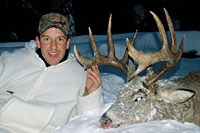 |
| Claudio Ongaro’s buck (bait). |
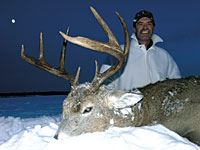 |
| Rob Miskosky’s buck (field). |
While baiting and artificial feeding may differ slightly—mainly in quantities of supplied feed—the congregation of deer to a feed source is the same. Studies have shown that in Canada and the U.S. artificial feeding programs have improved the reproductive success of ungulate populations. Studies have also shown that artificial feeding—or baiting—increases the fecundity and fawn survival of white-tailed deer. I can’t help but think that while I was nestled in a warm blind in -30 Celsius weather, the deer, especially the fawns, were somewhat grateful for the small amounts of feed my bait provided them.
Another program similar to baiting is called “intercept feeding”—the process of keeping wild ungulates from feeding on farmer’s crops. In 2000-2001, Saskatchewan paid out more than $2.2 million in compensation to farmers for crop damage from deer and other ungulates.
Baiting is also used as a means of controlling herd populations and the dispersal of bait laced with vaccine has also been used to successfully vaccinate a large number of wild animals in Ontario.
While this was the first time I had ever baited deer, I have to admit that I was pleasantly surprised by the excitement it brought to our Saskatchewan hunt. While I never did kill my deer over bait, both Claudio and Shawn did and both were extremely pleased with the outcome of their hunts.
But do the benefits of baiting outweigh the dangers that can be associated with it? Does it pit hunter against hunter? Jurisdiction against jurisdiction? And how does it reflect on the image of hunters to the non-hunting community?
Next month I’ll attempt to answer these questions with “The Great De-Bait: Part II. ■
For previous Outdoor Pursuits click here.
|


